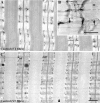Eccentric exercise-induced morphological changes in the membrane systems involved in excitation-contraction coupling in rat skeletal muscle
- PMID: 11389213
- PMCID: PMC2278631
- DOI: 10.1111/j.1469-7793.2001.0571a.x
Eccentric exercise-induced morphological changes in the membrane systems involved in excitation-contraction coupling in rat skeletal muscle
Abstract
1. Physiological evidence suggests that excitation-contraction (E-C) coupling failure results from eccentric contraction-induced muscle injury because of structural and morphological damage to membrane systems directly associated with the E-C coupling processes within skeletal muscle fibres. In this study using rats, we observed the ultrastructural features of the membrane systems of fast-twitch (FT) and slow-twitch (ST) muscle fibres involved in E-C coupling following level and downhill running exercise. Our aim was to find out whether mechanically mediated events following eccentric exercise caused disorder in the membrane systems involved in E-C coupling, and how soon after exercise such disorder occurred. We also compared the morphological changes of the membrane systems between ST and FT muscle fibres within the same muscles. 2. Single muscle fibres were dissected from triceps brachii muscles of male Fischer 344 rats after level or downhill (16 deg decline) motor-driven treadmill running (18 m min(-1), 5 min running with 2 min rest interval, 18 bouts). All single muscle fibres were histochemically classified into ST or FT fibres. The membrane systems were visualized using Ca(2+)-K(3)Fe(CN)(6)-OsO(4) techniques, and observed by high voltage electron microscopy (120-200 kV). 3. There were four obvious ultrastructural changes in the arrangement of the transverse (t)-tubules and the disposition of triads after the downhill running exercise: (1) an increase in the number of longitudinal segments of the t-tubule network, (2) changes in the direction and disposition of triads, (3) the appearance of caveolar clusters, and (4) the appearance of pentads and heptads (close apposition of two or three t-tubule elements with three or four elements of terminal cisternae of the sarcoplasmic reticulum). The caveolar clusters appeared almost exclusively in the ST fibres immediately after downhill running exercise and again 16 h later. The pentads and heptads appeared almost exclusively in the FT fibres, and their numbers increased dramatically 2-3 days after the downhill running exercise. 4. The eccentric exercise led to the formation of abnormal membrane systems involved in E-C coupling processes. These systems have unique morphological features, which differ between ST and FT fibres, even within the same skeletal muscle, and the damage appears to be concentrated in the FT fibres. These observations also support the idea that eccentric exercise- induced E-C coupling failure is due to physical and chemical disruption of the membrane systems involved in the E-C coupling process in skeletal muscle.
Figures






References
-
- Appelt D, Buenviaje B, Champ C, Franzini-Armstrong C. Quantitation of ‘junctional feet’ content in two types of muscle fiber from hind limb muscles of the rat. Tissue and Cell. 1989;21:783–794. - PubMed
-
- Armstrong RB, Ogilvie RW, Schwane JA. Eccentric exercise-induced injury to rat skeletal muscle. Journal of Applied Physiology. 1983;54:80–93. - PubMed
-
- Bar PRD, Reijneveld JC, Wokke JHJ, Jacobs SCJM, Bootsma AL. Muscle damage induced by exercise: Nature, prevention and repair. In: Salmons S, editor. Muscle Damage. Oxford, UK: Oxford University Press; 1997. pp. 1–27.
-
- Byrd SK. Alterations in the sarcoplasmic reticulum. A possible link to exercise-induced muscle damage. Medicine and Science in Sports and Exercise. 1992;24:531–536. - PubMed
Publication types
MeSH terms
Substances
LinkOut - more resources
Full Text Sources
Miscellaneous

